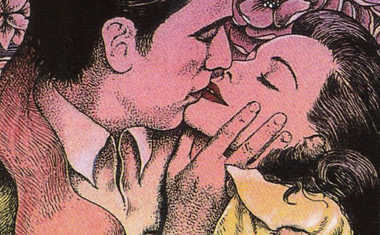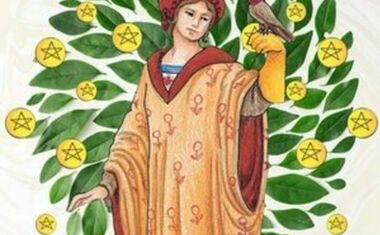
Franciscans Influence
Part VI of Catharism and the Tarot
The Albigensian Crusade had crushed the political and hierarchical infrastructure that supported the Cathars in Provence. The Inquisition persecuted the remnants in Provence and Italy for the next two centuries. But a third influence entered the scene and effected a final transformation, the Franciscan Friars.
We pointed out in previous chapters that the popular appeal of Catharism never rested with dualist theology. There was no systematic religious education and the ordinary believers knew little about theology. The appeal of Catharism lay in the presence of obviously holy men and women, the Perfecti, who lived with the people and ministered to their spiritual aspirations. In marked contrast to the corrupt clergy of the time, the Perfecti were following the precepts of Christ and seemed to provide direct access to that wisdom. To their protectors and sympathizers, the Cathari always seemed better Christians than their persecutors.
As the Inquisition made access to the Perfecti more and more difficult, the Franciscans appeared on the scene in Provence and Italy. In the eyes of the people the Franciscans must have looked pretty much like Perfecti (Davison, 1927). The radical poverty was identical. The early Franciscan women wandered along with the men and were given honored, if not equal, status (Lansing, 1998). Critical of Church corruption, encouraging individualist spirituality, chaste, dressed in simple tattered cloth, and living among the people, the Friars became a simple substitute and the common people flocked to them in great numbers (Lambert, 1998).
In fact, the similarity naturally raises the question of whether the Franciscans were derived from the Cathar Perfecti. The answer is a flat "No!" (Davison, 1927). We pointed out in previous chapters that Catharism had dual origins: a distinctive dualist theology which they inherited from the Bogomils superimposed on an archetypic drive for individualism spirituality which seems to be endemic to the European civilization. The Franciscans adopted much from this archetypic spirituality (Lambert, 1998), but there is no doctrinal overlap with the Cathar dualist theology (Lambert, 1977). Francis was meticulously loyal to orthodox Catholicism, accepting the sacraments, strict obedience to the Pope, the Incarnation, and all of the other elements that were rejected by Catharism.
Problems within the Franciscan order started soon after the death of Francis. The Pope wanted the Order to take on new responsibilities that would require them to own property and handle money. This was vehemently opposed by many Friars as violating Francis' vision. This opposition caused a split, resulting in a number of independent groups breaking away from the Order and forming the heretical Spiritual Franciscans and Fraticelli. The new groups were centered in Provence and Italy--and we find ourselves back on the main topic of how Catharism was transmitted to the Italian Renaissance.
Over time, the Spirituals wandered further and further from orthodoxy. They came to reject the Church as an evil force preventing them from following the strict rule of Francis. To justify their claim to authenticity, the Spirituals became the major commentators and propagators of Joachim's theory of history. About 1240, an abbot from Fiore carried the works of Joachim to the Franciscan house at Pisa (Reeves, 1976). The Spirituals immediately focused on Joachim's description of the transition to the New Age of the Holy Spirit.
Joachim was taken as justification for the claim that an extreme crisis was about the occur. The transition would be marked by the emergence of the Anti-Christ in the form of an evil Pope (Reeves, 1969). The evil pope was, of course, identified as the current persecutor of the Spirituals and the proper response was the total rejection of the Church. In the New Age, this evil Church would be overthrown but the transition would be traumatic and the righteous should expect great suffering. This served to give a theological significance to the persecutions that the Spiritualists were experiencing (Reeves, 1969).
Joachim had prophesied that the transition would be marked by the emergence of "spiritual men" who would lead humanity into the new age of enlightenment (McGinn, 1979). Needless to say, the Spirituals announced that they were those spiritual men! And although Joachim said little about poverty (Lambert, 1977), the Spirituals identified Franciscan poverty as the special mark of the prophesized spiritual men (Christie-Murray, 1976). Thus, the Spirituals found affirmation for their ideas and their role in history in Joachim. In 1254, John of Parma wrote a preface to a new edition of Joachim called the Eternal Gospel and proclaimed a new religion with no need for the evil Church or its sacraments (Christie-Murray, 1976).
The Spirituals disseminated and popularized the ideas of Joachim turning him into a major influence on subsequent intellectual history. Their version of Joachim proved to have remarkable flexibility. Subsequent dissidents identified the Anti-Christ with whatever temporal or spiritual agent opposed them. In sequence, the Dominicans, Augustinians, and Jesuits all justified their missions by claiming that they were the prophesized "spiritual men" (Reeves, 1969). Predicted dates for the final transition came and went without trauma, each time replaced by a new, improved prediction.
And although Catharism had little input to the original Franciscans, the same cannot be said of the followers of the Spirituals. Francis had organized his followers into three "orders." The first order was composed of the male Friars. The second order was composed of the females who wanted to enter religious life. But Francis was also inundated with requests for a deeper spiritual experience that was compatible with continued secular life. Francis formulated the "Tertiaries" to meet this demand.
Consciously or not, the Tertiaries were a close copy of the Cathar Credentes or believers, taking over their role in the culture and recruiting most of the remnant heretics. The movement embraced many types of people, from urban craftsmen and merchants to princes, nobles and ladies of royal or noble blood. Patterns of devotion ranged from guilds of workers and groups who founded hospitals or hospices to those who pursued the mystical or contemplative life (Lee et al., 1989). In the long run, providing a substitute that fulfilled the spiritual aspirations of the people proved more effective than the sword or the stake.
In Provence, the Tertiaries fell under the influence of the brilliant Spiritualist and Neoplatonist, Petrus Johannis Olivi (Lee et al., 1989) and became synonymous with the heretical Beguines. The term Beguine first appears at the end of the twelfth century and is probably derived from the word Al-BIGEN-sians (Leff, 1967). However, it is not clear whether the term implies a direct relationship with the Cathars or is simply a generalized term for heretic. The centers of the new heresy overlapped but were not identical with the Cathar towns. More importantly, there was no sign of Cathar doctrine in the Beguines and both Olivi and his fanatical followers were firmly opposed to Catharism (Lambert, 1977).
Nevertheless, there are some reasons to be suspicious that the Beguines included remnants of Catharism. For example, the word "consolation" is given particular importance: "consolation is granted to those who have humble hearts...and who are open to and worthy of knowledge of the imminent coming of the Last Times" (Lee et al., 1989). That concept could be a transformed relic of the Cathar initiation or consolamentum. As another example, in 1325, Prous Boneta was interrogated at Montpellier, a center of Beguine activity. Her confession is a strange mixture of Catharism and Joachimism (Reeves, 1969). In 1387, Inquisitors discovered a remnant Cathar group in the valleys of the Alps, working in intense secrecy, meetings at night, imposing oaths against betrayal, and using secret sign of recognition (pressing little fingers together). The significant point is that one of the leaders of the group was an ex-Tertiary.
It is important to recognize that the Spiritual/Joachim heresy and the associated Tertiaries were not centered in Provence. They extended throughout Italy and into Spain and Germany. The groups were not formed into any central organization but were in communication and shared a body of commentaries on Joachim (Lee et al., 1989)
In Italy, Ubertino da Casale (1253-c1341), a student of Olivi, wrote "Arbor Vitae" based on the "Lignum Vitae" of Bonaventura (Douie, 1978). Using the imagery of the Tree of Life from Joachim (Reeves and Hirsch-Reich, 1972) the manuscript was widely circulated in the venacular and was extremely popular. One suspects that when the 16th century Christian Cabalists started representing the QBLH tree, they were influenced by such Joachimite documents. Indeed, this is the closest I have ever come to finding a connection to a QBLH Tree diagram that would have been readily accessible when the Tarot appeared in 15th century Italy: Joachim"s tree, influenced by his Spanish Jewish friend, Petrus Alphonsi (Reeves, 1976), and transmitted by the Spiritual Franciscans. In the 14th century, the Joachimite treatise, Breviloquium, arrived in Catalonia (Lee et al., 1989). Scholem (1962) notes that this was probably too late to have influenced the QBLH doctrines of the millenium.
Another fascinating Spiritualist document, Vaticinia de Summis Pontificibus, appeared in Italy about 1304. Grundmann (1929a, b) points out that they were modeled on the Oracles of Leo c1180. Each page of the treatise shows an image of a pope with caption and oracular text. By the second half of the 14th century, two versions had been combined into a collection of thirty images. A large number of copies of the treatise were woodblock printed and circulated throughout the 15th century (Reeves, 1999). Surely, many would have noticed the connection between the Tarot Pope and this Spiritualist treatise!
As we have seen with both Catharism and Joachimism, the Spiritual Franciscans endured in Italy long after the Inquisition had extinguished the heresy elsewhere. Throughout the 14th century, the Fraticelli found admirers and protectors, even among orthodox bishops (Douie, 1978). Florence was under an interdict for its refusal to obey papal orders, and became in a place of refuge in defiance of that interdict. In 1484, the archbishop of Florence was still complaining to the pope that the Fraticelli had not been eliminated from his diocese (Douie, 1978).
Milan remained another refuge because the citizens' prized their independence so highly that they preferred to tolerate heretics rather than surrender to the demands of their bishops or of popes' (Lambert, 1977). The last recorded trial of Fraticelli was 1466 in Rome, so it is clear that the Spiritualists were still influential when the Tarot first appeared, sometime before 1440.
But, in fairness, it should be noted that the Church's treatment of the Spirituals was never monolithic. Groups that declared the Church to be the "whore of Babylon" and the pope to be the anti-Christ were relegated to the flames. But more moderate groups, that simply wanted to follow the inspiration of Francis, were treated more kindly. For example, in 1417, the papal vicar at Rome, Cardinal Isolani, took small groups of hermits near Rome under his personal protection (Douie, 1978). In 1446, the church gave an abandoned abbey to a group of Spiritual hermits and rather than forcefully disbanding them, encouraged them to join one of the recognized orders (Leff, 1967). In 1473, 1510, and 1581, moderate Spiritual groups were reunited with the Franciscan order (Douie, 1978).
So, by the middle of the 15th century, when the Tarot first appears in the city-states of Italy, Joachimism, Spiritual Franciscans, and Catharism--transformed through the institution of the Franciscan Tertiaries--were all present and their popular influence is well-documented. But what is most important is that all of this esoteric activity and persecution had left as its inheritance a totally orthodox social institution--the Catholic Confraternity!
References
Christie-Murray, D. 1976. A History of Heresy.New English Library. rprtd. 1989. Oxford University Press, Oxford.
Davison, E. S. 1927. Forerunners of Saint Francis. Houghton Mifflin, NY.
Douie, D. L. 1932. The Nature and the Effect of the Heresy of the Fraticelli. University of Manchester Press. Rpt. AMS 1978.
Grundman, H. 1929a "Die Papstprophetien des Mittelalters." Archiv fur Kulturgeschichte. XIX: 77-159.
Grundman, H. 1929b "Die Liber de Flore." Historisches Jahrbuch. XLIX:33-91.
Lambert, M. 1977. Medieval Heresy: Popular Movements from the Gregorian Reform to the Reformation. Blackwell, Oxford. 1992.
Lambert, M. D. 1998. Franciscan Poverty. St. Bonaventure University, St. Bonaventure, NY.
Lansing, C. 1998. Power and Purity: Cathar Heresy in Medieval Italy. Oxford University Press, NY.
Lee, H., M. Reeves, G. Silano. 1989. Western Mediterranean Prophesy: The School of Joachim of Fiore and the Fourteenth-century "Breviloquium." Pontifical Institute of Medieaval Studies, Toronto.
Leff, G. 1967. Heresy in the Later Middle Ages: The Relation of Heterodoxy to Dissent, c1250-1450. Manchester Univ Press, Manchester.
McGinn, B., trans. 1979. Apocalyptic Spirituality. Paulist Press.
Reeves, M. 1969. The Influence of Prophesy in the Later Middle Ages. Oxford University Press. rprtd. University of Notre Dame Press. 1993.
Reeves, M. 1976. Joachim of Fiore and the Prophetic Future. SPCK, London. 1999 Suton, Gloucestershire.
Reeves, M. and B. Hirsch-Reich. 1972. The Figurae of Joachim of Fiore. Oxford University Press, Clarendon Press.
Reeves, M. 1999. The Prophetic Sense of History in Medieval and Renaissance Europe. Ashgate Publishing, Vermont.
Scholem, G. 1962. Origins of the Kaballah. Trans. Jewish Publication Society, Princeton University Press, 1987.



